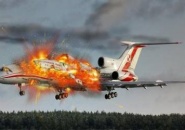Recommended:
- The Smolensk Conferences. A Preliminary Summary and Conclusion
- NEW STUDY: Putin's Russian inquiry into the Polish Air Force One crash in Smolensk
- 15 SIMPLE FACTS THE WORLD SHOULD KNOW
- Smolensk Reader's Digest. 23 pages, all the facts.
- Polish Military Intelligence was warned of a possible terrorist threat against one of the EU Member States' aircraft.
- Story behind the "1:24"
In reference to an article published in the weekly newsmagazine “Do Rzeczy”, the Chief Military Prosecutor's Office issued a statement admitting that in addition to TNT, devices used in Smolensk on the wreckage of the plane detected nitro compounds, octogen (HMX) and hexogen (RDX)
Investigative journalist, Cezary Gmyz, in Do Rzeczy weekly magazine (issued April 22, 2013) claims devices used by experts in 2012 on samples of the wreckage in Smolensk detected in addition to TNT, nitro compounds, octogen (HMX), hexogen (RDX), as well as paramononitrotoluene (p-MNT).
On the same day, in reference to the article, the Chief Military Prosecutor's Office issued a statement on its website admitting that in fact devices used by the experts in Smolensk pointed to the presence of various explosive substances, in addition to TNT, such as: octogen and hexogen.
http://www.npw.gov.pl/491-Prezentacjanewsa-45503-p_1.htm
In reference to the article published in the latest issue of the weekly newsmagazine “Do Rzeczy”, indicating that devices used by experts in Smolensk pointed to the presence of explosive materials: octogen and hexogen, the Chief Military Prosecutor's Office would like to herby inform that: text information that appeared on the displays of devices used by experts and specialists from the Central Forensic Laboratory and the Central Bureau of Investigation for screening tests indicated the presence of chemical substances, possibly associated with high-energy materials, including explosive materials, such as: trinitrotoluene (TNT), nitro-compounds, octogen (HMX) and hexogen(RDX).
The appearance of specific text on display of devices does not mean that explosive materials were present in the analysed part of the wreckage. The unequivocal answer regarding this matter will be given in the form of a statement made after thorough laboratory examination. Information that text, symbols of explosive materials, appeared on the displays of devices, should not make us jump to conclusions. The same experts and specialists on 12 November 2012 (that is soon after returning from Smolensk) have conducted an appraisal experiment, with an aim to verify the findings of the devices used in proceedings conducted in Smolensk. For this purpose they used an identical twin plane to the TU-154M No. 101 plane – the 102 plane which was situated in Mińsk Mazowiecki. For the purpose of this experiment, the same devices, as those used in Smolensk, have been used. Various elements of TU 154 M No. 102 have been examined, including: crew seats, seatbelts of crew seats, seatbelts of passenger seats and VIP interior. According to the results of the experiment, the devices in several places of the plane reacted in the very same way as those is Smolensk, indicating the possible presence of high-energy materials, including explosive materials, such as: TNT, HMX, RDX.
Back in October 2012, Rzeczpospolita daily ran its front page article, “Trotyl na wraku tupolewa” [TNT in Tupolev’s wreckage] by the same author - Cezary Gmyz, suggesting that traces of TNT and nitro-glycerine had been discovered on the debris of the presidential plane that crashed in Smolensk. In the aftermath of the publication, the publisher and owner of the daily Grzegorz Hajdarowicz, fired investigative journalist Cezary Gmyza, as well the daily's editor-in-chief Tomasz Wroblewski, his deputy and the papers head of the national department. Further surprising is the dismissal of the deputy editor-in-chief who was on leave at the time and hence was not involved in the preparation or publication of the article.
Concern has been raised by information where political pressure has been exerted by the ruling party on the owner and publisher of the Rzeczpospolita daily regarding the dismissals.
Cezary Gmyz repeated on many occasions that his information was certain and based on testimonies leaked from the prosecution, protecting throughout the identity of his informants.
According to the Prosecutor's Office, only laboratory examination will be ultimately able to prove the actual presence or lack of explosive materials on the wreckage, and not text displayed of specific devices and equipment.
- Jan Bokszczanin, the producer of devices capable of detecting traces of potential explosive materials, confirms that RDX and HTX belong to the group of “explosive substances”, which are used to produce modern explosive materials, such as C4. He assures that those materials cannot be confused by the specific devices with any other materials. Moreover, he states that those substances are “significantly more powerful than TNT” and have “much more explosive power”.
Chronology:
- - On October 30, 2012, Rzeczpospolita daily ran its front page article suggesting that traces of TNT and nitro-glycerine had been discovered on the debris of the presidential plane that crashed in Smolensk http://smolenskcrash.eu/news-47-background-on-tnt-rzeczpospolita-publication.html
- - On April 22, 2013, the Military Prosecutor's Office in a released statement admitted that in addition to TNT, devices detected nitro compounds, octogen (HMX) and hexogen (RDX) http://www.npw.gov.pl/491-Prezentacjanewsa-45503-p_1.htm





